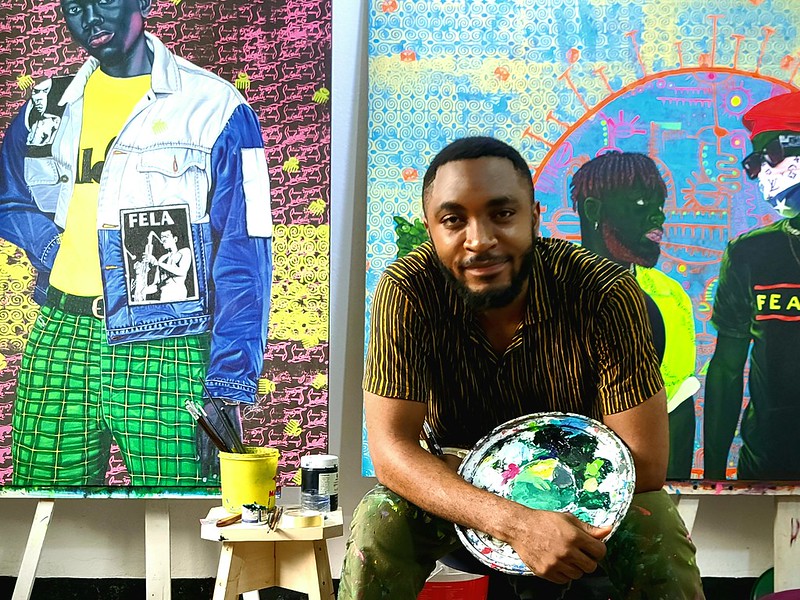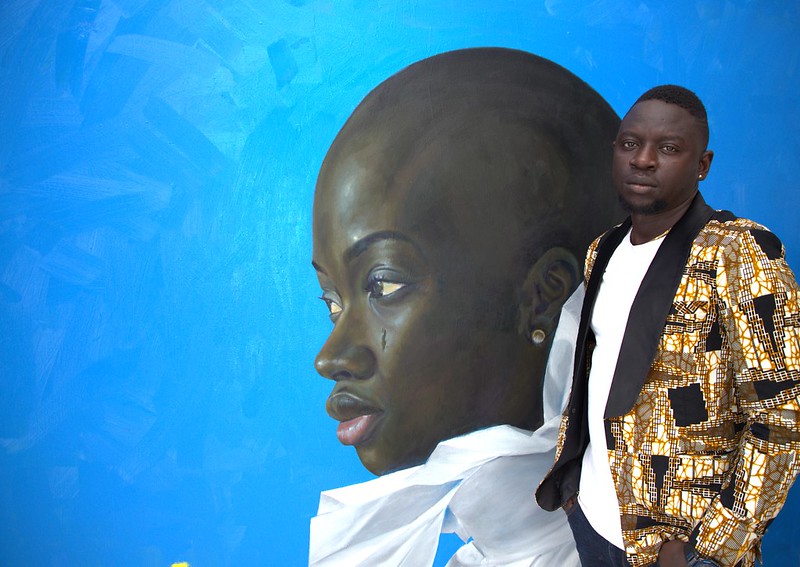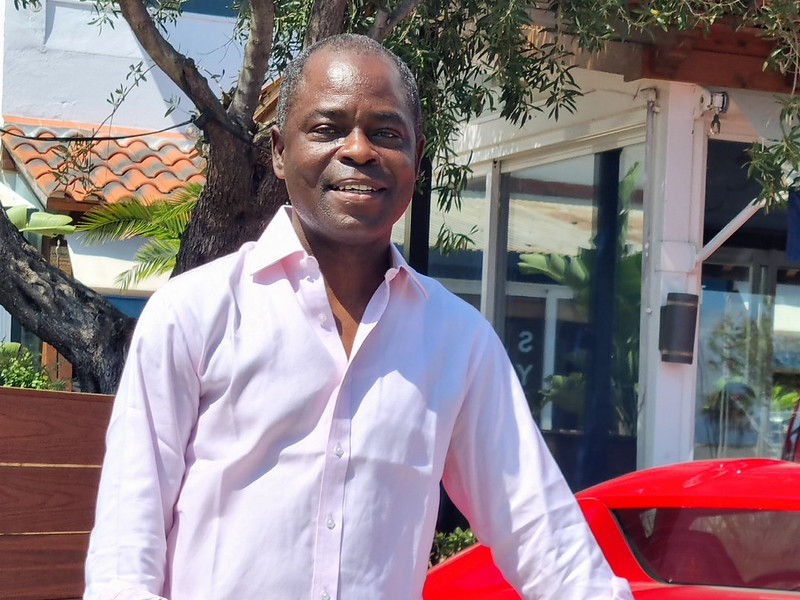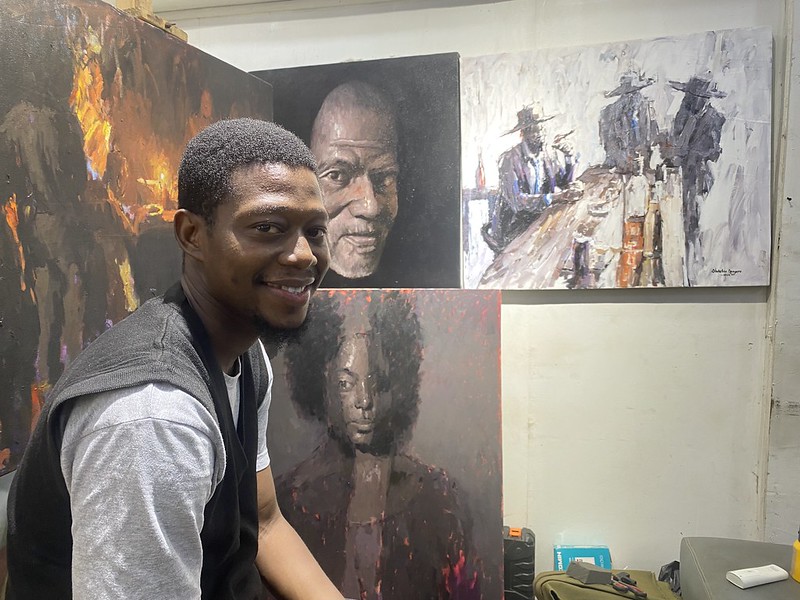
Six African Figurative Artists You Should Know, a new exhibition at OOA Gallery, places black figurative painting at the forefront of contemporary art discourse.
 The exhibition will feature the work of six painters from the African continent includine Oluwole Omofemi, Ebenezer Akinola, Oliver Okolo, Opeyemi Matthew Olukotun, Daniel Onguene, and Boris Anje (Anjel). Al six of these visual artists use figurative painting to interpret the world around them, to create tender depictions that tell stories about the interior worlds of their subjects
The exhibition will feature the work of six painters from the African continent includine Oluwole Omofemi, Ebenezer Akinola, Oliver Okolo, Opeyemi Matthew Olukotun, Daniel Onguene, and Boris Anje (Anjel). Al six of these visual artists use figurative painting to interpret the world around them, to create tender depictions that tell stories about the interior worlds of their subjects
From December 9, 2023 to January 7, 2024
Opening on December 9 at 7:30 p.m. with cava cocktail and live Gospel songs by Marlène Diva
Sometimes we look at figurative paintings to better understand ourselves. We visit museums and galleries to get a glimpse of portraits that appear to gaze back at us, engaging them in a silent back-and-forth, an unspoken negotiation. The Mona Lisa (ca. 1503–19) seems to tease us with a condescending smirk; in Las Meninas (1656), Infanta Margarita Teresa stares us down with an imperial glare; and the Girl with a Pearl Earring (ca. 1665) locks eyes with us as she slightly parts her lips. When we look up at these portraits, we can’t help but feel that these figures are exalted or majestic or one step away from godliness. But how are we ever supposed to see ourselves, to truly engage in that silent exchange, if the subjects of these paintings never resemble us?
Historically, it has been difficult for members of the African diaspora to see ourselves represented in such paintings. However, this is beginning to change as contemporary artists like Kerry James Marshall, Kehinde Wiley, Amy Sherald, Henry Taylor, Jordan Casteel, and several others are at the forefront of the genre. The increased visibility for black figurative painters has led to a shift in the dialogue around painting and identity and has given more black artists the opportunity to showcase their work in places Figurative Art is More Alive than Ever! Six African Figurative Artists you should Know, a new show at OOA Gallery, places Black figure painting at the forefront of discourse about contemporary art. The exhibition will feature the work of six painters from the African continent, including Oluwole Omofemi, Ebenezer Akinola, Oliver Okolo, Opeyemi Matthew Olukotun, Daniel Onguene, and Boris Anje (Anjel). All six of these visual artists use figurative painting to interpret the world around them, to create tender depictions that tell stories about the interior worlds of their subjects. where they had previously been excluded.
“Figurative art holds a profound significance in the realm of contemporary African art,” OOA gallery director Sorella Acosta said. “[It] serve[s] as a powerful medium through which artists express complex narratives, cultural heritage, and social commentary. In the vibrant tapestry of Africa’s artistic landscape, figurative art acts as a bridge between tradition and modernity, offering a compelling fusion of ancestral themes with contemporary expressions.”
Several pieces in the show exemplify this complex cultural commentary. For example, Boris Anje’s “Erin Niguel earrings” (2022) are tender depictions of Black femininity—the figures in this work are rendered in vivid greens, which makes the figures emanate with a ghostly glow. Both subjects in the painting don large blue and red hoop earrings, making the women appear regal, like these items of jewelry elevate them to a royal status.
As Sumiko Wilson writes in Elle Magazine, “Wearing bold, chunky, shiny gold hoops was a way of unabashedly asserting one’s identity in a society that demanded that women of color do the opposite and shrink themselves. So, it wouldn’t be a stretch to call them emblems of resistance.”

Boris Anje (Anjel)
Other works in the exhibition, such as Oluwole Omofemi’s “Of the Pink” (2023) are similarly striking and offer tender portrayals of Black women. This 151- by 137-cm canvas shows a woman with short hair set against a magenta backdrop. The subject has large, orb-shaped eyes; her full lips are pursed together; she wears a frock adorned with an abstract blue and pink pattern. She looks at the viewer straight on, with a directness that is both assertive and intriguing.
“My heart has always been the kind of reflection of my existence, my community and the things that I see around me,” Omofemi said.
Born in Nigeria in 1988, Omofemi loved to express his creativity as a child, drawing pictures on the floor of his home. Later, he used drawing books to hone his techniques and developed skills in oil and acrylic painting, eventually displaying his art in countries including Lagos, Spain, Italy, Belgium and Ghana.
Omofemi’s recent works are testament to his virtuosic painting skills. “Desire” (2023)—which is another piece he has featured in the show—also seems true to its title: The piece depicts a woman gazing off into the distance, and it feels like there’s a yearning in her eyes. She stands against a solid red backdrop, which brings out the warm undertones of her skin and helps viewers conjure emotions similar to those expressed in the title of the painting. Red is often associated with lust and sensuality, and the subject’s bare shoulders seem to suggest a kind of eroticism without oversexualising the subject.
“I’m able to interpret [the world] in the way that it looks to me,” Omofemi said. “So, for me, figurative art is a kind of representation of memory or of people.”

Oluwole Omofemi
Other artists in the show also use figuration as a useful vehicle for storytelling. For example, Ebenezer Akinola uses both realism and abstraction in his work to “challenge notions of race, gender, beauty, identity and contemporary African politics and spirituality,” as he wrote in his artist biography. Born in Ibadan in 1968, Akinola earned a bachelor’s degree in painting from the University of Benin in 1989 and has continued to develop his skills as a painter since then.
His painting “Good Gall I” (2023) depicts a woman set against a mustard-colored background. She sits on a bright pink bench, holding her head in her hand as she slyly gazes at the viewer from the corner of her eye. The gold features on her black handbag nicely compliment the yellow undertones of the mustard backdrop. These colors work together to create a sense of cohesion; they lend the painting a kind of dynamic quality that keeps the viewer’s eye moving around the entire painting.

Ebenezer Akinola
Oliver Okolo’s painting “Serenity” (2023) uses color to create the opposite effect. Akinola’s “Good Gall I” (2023) used saturated hues to tell a vibrant story about the painting’s subject, whereas Oloko’s canvas presents a more muted narrative bathed in grays, soft greens, and browns. “Serenity” shows a young man looking straight at the viewer. The subject dons an olive-green shirt, and a high afro, and his lips are pressed together in a stern line. The blank background and calming colors help to create a sense of ease, and the blank expression on the subject’s face encourages the viewer to find the same kind of internal reflection that the subject has.
“The sense of peace is a concept everyone tends to want in their lives at some point,” Okolo said. “Maybe as one gets old[er] they want a sense of calmness around them, and they want to feel love like never before. This triggers the urge to explore in the mind of a person who is actually in the serene space in their mind. I have used this portrait to cross examine the emotion and the state of mind of an individual in a serene state of mind.”
Okolo often uses portraiture as a means of cultural commentary. The Nigerian artist was born in 1992; as a child, he dreamed of becoming a basketball star and an artist. Eventually, he made the former dream into a reality, after he “started making art with charcoal pencils, so when I began to introduce oils into the work, I thought to keep all of the materials that I loved to work with in the process of making paintings.” Now, as an adult, Okolo has displayed his work internationally, in countries including Spain, Sweden, the United States, and Nigeria.

Oliver Okolo
Similarly, to Okolo, Opeyemi Matthew Olukotun’s work “In Between II” (2022) presents a subject who is apparently in the midst of personal reflection. The figure in this portrait is rendered in deft, impressionist brushstrokes. She wears a black, red, and white patterned shirt that compliments the impassioned texture of her skin. And her eyes are a wellspring of emotion; they meet our gaze in a sidelong stare that seems to suggest that she has a serious story to tell us.
“The body of work I featured in this exhibition expresses my thoughts and state of mind on every piece,” Olukotun said. “Most of them range from topics around thoughts, feelings, and patriotism, thus creating intentional and deeper meanings than regular portraits. These works can convey different definitions or interpretations to viewers because we see things differently.”
Born in Ipetu Ijesha, Osun State in 1989, Olukotun graduated from Ladoke Akintola University of Technology, Ogbomoso, Oyo State, Nigeria with a degree in Fine and Applied Arts in 2012. Later, he began his career as a creative art teacher in an upper secondary school and has participated in several group exhibitions in Nigeria since then.

Opeyemi Matthew Olukotun
In contrast to Olukotun’s work, Daniel Onguene’s “Saison de courage” (2022), hints at a kind of innocence. The painting portrays a young boy carrying lemons on top of his head. Red plants frame the boy’s body, and the subject looks into the distance with a slightly perplexed face.
“As a whole, my work is based on the notion of de-marginalizing those left behind of society,” Onguene said. “I’m talking about an Africa that still bears the scars of imperialism and in which my fellow human beings and I struggle to exist.”
Born 1995 in Bafoussam, Cameroon, Onguene holds a master’s degree in visual arts and art history, with a focus on painting, from the Institute of Fine Arts of the University of Douala in Nkongsamba. Since beginning his career in fine art, Onguene has displayed work in Barcelona, Spain; London, UK; and elsewhere.

Daniel Onguene
All of the artists featured in this exhibition drew from their unique backgrounds to weave complex narratives about home, personal histories, and African culture. They use a variety of different techniques to make commentary on broader cultural phenomena, which feels especially relevant in the wake of recent societal discussions about race and identity following the 2020 Black Lives Matter movement.
“One of the primary reasons for the importance of figurative art in African contemporary art lies in its ability to preserve and celebrate the rich diversity of African cultures,” Acosta said. “Through the depiction of human figures, artists pay homage to their roots, traditions, and customs. These representations serve as a visual language, communicating stories of resilience, identity, and community bonds. Figurative art becomes a vessel through which Africa’s multifaceted heritage is both preserved and redefined for future generations.”







